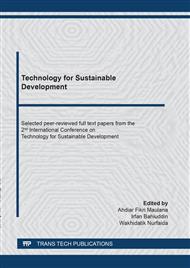[1]
T. N. Q. Tram, C. G. T. Tai, and D. T. B. Thuy, User interface design pattern Management System Support for Building Information System,, 2006 1st Int. Conf. Digit. Inf. Manag., p.96–101, 2007,.
DOI: 10.1109/icdim.2007.369336
Google Scholar
[2]
M. D. Lytras, F. Garcia-Peñalvo, and P. Ordóñez De Pablos, Advanced human-computer interaction,, Computers in Human Behavior, vol. 29, no. 2, p.305–306, (2013).
DOI: 10.1016/j.chb.2012.11.018
Google Scholar
[3]
R. Miñón, L. Moreno, P. Martínez, and J. Abascal, An approach to the integration of accessibility requirements into a user interface development method,, Sci. Comput. Program., vol. 86, p.58–73, 2014,.
DOI: 10.1016/j.scico.2013.04.005
Google Scholar
[4]
Å. Granlund, D. Lafrenière, and D. A. Carr, A Pattern-Supported Approach to the User Interface Design Process,, Proc. HCI Int. 2001 9th Int. Conf. Human-Computer Interact., vol. 9, p.1–5, 2001, [Online]. Available: http://www.sm.luth.se/csee/csn/publications/ HCIInt2001Final.pdf.
Google Scholar
[5]
J. O. Borchers, A pattern approach to interaction design,, AI Soc., vol. 15, no. 4, p.359–376, 2001,.
Google Scholar
[6]
N. Capuano, G. D'Aniello, A. Gaeta, and S. Miranda, A personality based adaptive approach for information systems,, Comput. Human Behav., vol. 44, p.156–165, 2015,.
DOI: 10.1016/j.chb.2014.10.058
Google Scholar
[7]
R. Yan, Icon design study in computer interface,, in Procedia Engineering, 2011, vol. 15, p.3134–3138,.
DOI: 10.1016/j.proeng.2011.08.588
Google Scholar
[8]
N. Hollender, C. Hofmann, M. Deneke, and B. Schmitz, Integrating cognitive load theory and concepts of human-computer interaction,, Comput. Human Behav., vol. 26, no. 6, p.1278–1288, 2010,.
DOI: 10.1016/j.chb.2010.05.031
Google Scholar
[9]
A. González-Torres, F. J. García-Peñalvo, and R. Therón, Human–computer interaction in evolutionary visual software analytics,, Comput. Human Behav., vol. 29, no. 2, p.486–495, Mar. 2013,.
DOI: 10.1016/j.chb.2012.01.013
Google Scholar
[10]
O. A. Alsos, A. Das, and D. Svanæs, Mobile health IT: The effect of user interface and form factor on doctor-patient communication,, Int. J. Med. Inform., vol. 81, no. 1, p.12–28, 2012,.
DOI: 10.1016/j.ijmedinf.2011.09.004
Google Scholar
[11]
J. Kim, A. Lee, and H. Ryu, Personality and its effects on learning performance: Design guidelines for an adaptive e-learning system based on a user model,, Int. J. Ind. Ergon., vol. 43, no. 5, p.450–461, 2013,.
DOI: 10.1016/j.ergon.2013.03.001
Google Scholar
[12]
S. V Pantazi, A. Kushniruk, and J. R. Moehr, The usability axiom of medical information systems,, Int. J. Med. Inform., vol. 75, no. 12, p.829–839, 2006,.
DOI: 10.1016/j.ijmedinf.2006.05.039
Google Scholar
[13]
K. Sousa, H. Mendonça, and J. Vanderdonckt, User Interface Development Life Cycle for Business-Driven Enterprise Applications,, 2009, p.23–34.
DOI: 10.1007/978-1-84882-206-1_3
Google Scholar
[14]
R. Mahanti, The Application of Quality Function Deployment to User Interface Design,, Qual. Manag. J., vol. 16, no. 1, p.29, (2009).
Google Scholar
[15]
Y. Lee, Y. H. Chao, and S. Lin, Structural approach to design user interface,, Comput. Ind., vol. 61, no. 7, p.613–623, 2010,.
Google Scholar
[16]
A. Seffah and M. Taleb, Tracing the evolution of HCI patterns as an interaction design tool,, Innov. Syst. Softw. Eng., vol. 8, no. 2, p.93–109, 2012,.
DOI: 10.1007/s11334-011-0178-8
Google Scholar
[17]
J. W. Bang, E. C. Lee, and K. R. Park, New computer interface combining gaze tracking and brainwave measurements,, IEEE Trans. Consum. Electron., vol. 57, no. 4, p.1646–1651, 2011,.
DOI: 10.1109/tce.2011.6131137
Google Scholar
[18]
C. Zickler, S. Halder, S. C. Kleih, C. Herbert, and A. Kübler, Brain painting: Usability testing according to the user-centered design in end users with severe motor paralysis,, Artif. Intell. Med., vol. 59, no. 2, p.99–110, 2013,.
DOI: 10.1016/j.artmed.2013.08.003
Google Scholar
[19]
E. M. Holz, J. Höhne, P. Staiger-Sälzer, M. Tangermann, and A. Kübler, Brain-computer interface controlled gaming: Evaluation of usability by severely motor restricted end-users,, Artif. Intell. Med., vol. 59, no. 2, p.111–120, 2013,.
DOI: 10.1016/j.artmed.2013.08.001
Google Scholar
[20]
C. Ziemkiewicz et al., How visualization layout relates to locus of control and other personality factors,, IEEE Trans. Vis. Comput. Graph., vol. 19, no. 7, p.1109–1121, 2013,.
DOI: 10.1109/tvcg.2012.180
Google Scholar
[21]
S. N. Abbas, M. Abo-Zahhad, and S. M. Ahmed, State-of-the-art methods and future perspectives for personal recognition based on electroencephalogram signals,, IET Biometrics, vol. 4, no. 3, p.179–190, 2015,.
DOI: 10.1049/iet-bmt.2014.0040
Google Scholar
[22]
K. Das, S. Z. S. Zhang, B. Giesbrecht, and M. P. P. M. P. Eckstein, Using rapid visually evoked EEG activity for person identification,, Conf Proc IEEE Eng Med Biol Soc, vol. 2009, p.2490–2493, 2009,.
DOI: 10.1109/iembs.2009.5334858
Google Scholar
[23]
C. N. Gupta, R. Palaniappan, and R. Paramesran, Exploiting the P300 paradigm for cognitive biometrics,, Int. J. Cogn. Biometrics, vol. 1, no. 1, p.26, 2012,.
DOI: 10.1504/ijcb.2012.046513
Google Scholar
[24]
R. Palaniappan, Method of identifying individuals using VEP signals and neural network,, IEE Proc.-Sci. Meas. Technol, vol. 151, no. 5, p.16–20, 2004,.
DOI: 10.1049/ip-smt:20040003
Google Scholar
[25]
H. Touyama, EEG-Based Personal Identification,, Intech, (2009).
Google Scholar
[26]
S. K. Yeom, H. Il Suk, and S. W. Lee, Person authentication from neural activity of face-specific visual self-representation,, Pattern Recognit., vol. 46, no. 4, p.1159–1169, 2013,.
DOI: 10.1016/j.patcog.2012.10.023
Google Scholar
[27]
B. C. Armstrong, M. V. Ruiz-Blondet, N. Khalifian, K. J. Kurtz, Z. Jin, and S. Laszlo, Brainprint: Assessing the uniqueness, collectability, and permanence of a novel method for ERP biometrics,, Neurocomputing, vol. 166, p.59–67, 2014,.
DOI: 10.1016/j.neucom.2015.04.025
Google Scholar
[28]
R. Das, E. Maiorana, and P. Campisi, EEG Biometrics Using Visual Stimuli: A Longitudinal Study,, IEEE Signal Process. Lett., vol. 23, no. 3, p.341–345, 2016,.
DOI: 10.1109/lsp.2016.2516043
Google Scholar
[29]
R. Das, E. Piciucco, E. Maiorana, and P. Campisi, Visually Evoked Potentials for EEG Biometric Recognition,, (2016).
DOI: 10.1109/splim.2016.7528407
Google Scholar
[30]
I. Perdana, P. Insap, N. Akhmad, and S. Wimbarti, Confirmation of Personality Types Using Visual Evoked Potential with User Interface Design Stimulus – A Research Plan,, Turkish Online J. Qual. Inq., vol. 12, no. 9, p.4130–4138, 2021, [Online]. Available: https://www.tojqi.net/index.php/journal/article/view/6428.
DOI: 10.3844/jcssp.2021.1138.1146
Google Scholar


